Location
Our Washington Location
Our inpatient facility is located in Washington, and will serve Washington state. It will provide a safe & therapeutic environment for both our staff and patients.
- Edmonds
7416 212th St SW,
Edmonds, WA 98026
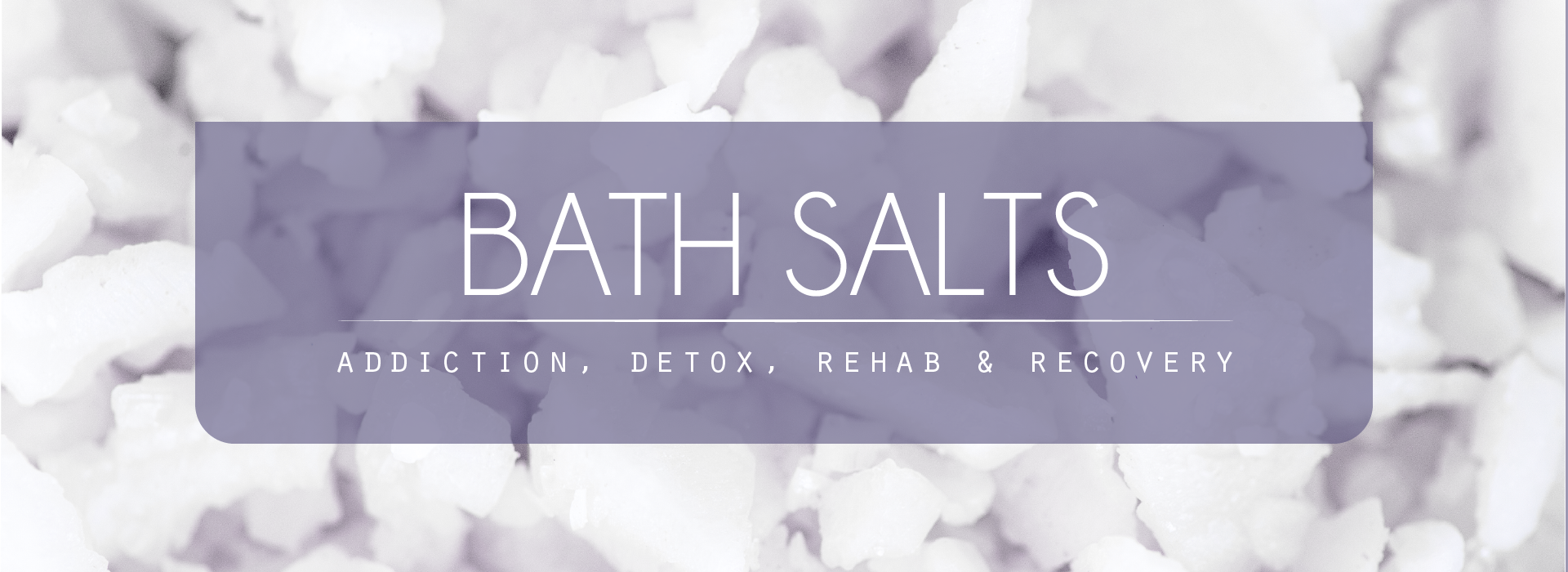
For those who suffer from bath salts addiction, detox and rehab are the answers they are looking for to recover. This is a designer drug, and it is one that people can get addicted to fairly quickly once they start using it. The good news is that it is possible to get off it.
Using bath salts carries so many risks that most people are unaware of. Those who use it are often much more interested in the high it produces than in the dangers of it. The reality is that this drug can have a long list of negative consequences after using it just one time.
We want to provide people with the information they need to recover from bath salts addiction. But we also want to clarify the dangers of this drug so people understand the risks of continuing to use it.
Using bath salts is an inexpensive, but risky way to get high. Their use has increased dramatically over the last few years, and it is a drug that some say turns people into zombies. As of today, thousands of uses have been reported all over the United States. They were created as a synthetic stimulant, and they got their name from the bath salts that people use to bathe with.
The term bath salts does not refer to any one drug in particular. It refers to a group of substances that mimic a drug that is typically found in the Khat plant. They may be sold anywhere under a variety of product names, such as jewelry cleaner, plant food or cell phone screen cleaner. They are labeled “not for human consumption,” and this allows the marketers to avoid getting into trouble with law enforcement.
This drug goes by a number of different names on the street, such as:

There are actually many more as well. But regardless of what it is called, no one really knows what is in it. The mix can be incredibly varied, which makes this drug all the more dangerous to consume.
Most people think of crystal meth as being one of the most addictive drugs on the planet. The reality is that scientists believe that bath salts may be even more addictive.
In a study that was published in the Journal of Neuropharmacology, rats were given doses of meth and doses of bath salts. The rats worked a lot harder to get additional doses of the bath salts. They would press a lever around 600 times for this drug, and only around 60 times to get meth.
They showed many of the classic signs of intoxication after using bath salts. Their behaviors included biting, excessive licking, and a lot of activity. This confirmed the fact that this drug is, indeed, a very strong stimulant.
It is very difficult to say what the active ingredient in bath salts is. Some of them may contain MDPV, or methylenedioxypyrovalerone. But, since it hit the streets, illegal chemists have found many ingredients that will work just as well.
Dr. Zane Horowitz is an emergency room doctor and the medical director of the Oregon Poison Center. He states that, “Nobody really knows, because there has been no way to test for these substances. However, that is changing, and some tests for some of these chemicals have been developed.”
The Synthetic Drug Abuse Prevention Act made it illegal to possess, use or distribute a lot of the chemicals that are used to make bath salts in 2012. This law covers 26 different chemicals, which are now labeled as Schedule 1 drugs. These are substances that have no medicinal value, but that do have high abuse potential.
The very name of bath salts makes them sound like something that should be completely harmless. In fact, many people confuse them with Epsom salts, assuming that they are the same thing. This could not be further from the truth.
Because this drug can have any number of chemical compositions, it is hard to define a standard type of high. The reaction that people have when using it can take on many different forms. Typically, bath salts cause people to experience hallucinations and act strangely. Some may even go off on a murderous rage.
People often say that the high they experience is not worth it once they realize what is happening to them. This is a drug that causes people to do strange things. They feel like their losing their minds, and at times, the drug can also have fatal consequences.
Doing bath salts sounds like a fun experiment to many people. But most of them realize that it is not fun at all. It is dangerous, but it can quickly lead to an addiction that makes them feel like they need to have them all the time.
Bath salts carries a long list of side effects. These can change depending on how long a person has been using this drug. It is important to note that this is a substance that can have a profound effect both physically and psychologically.
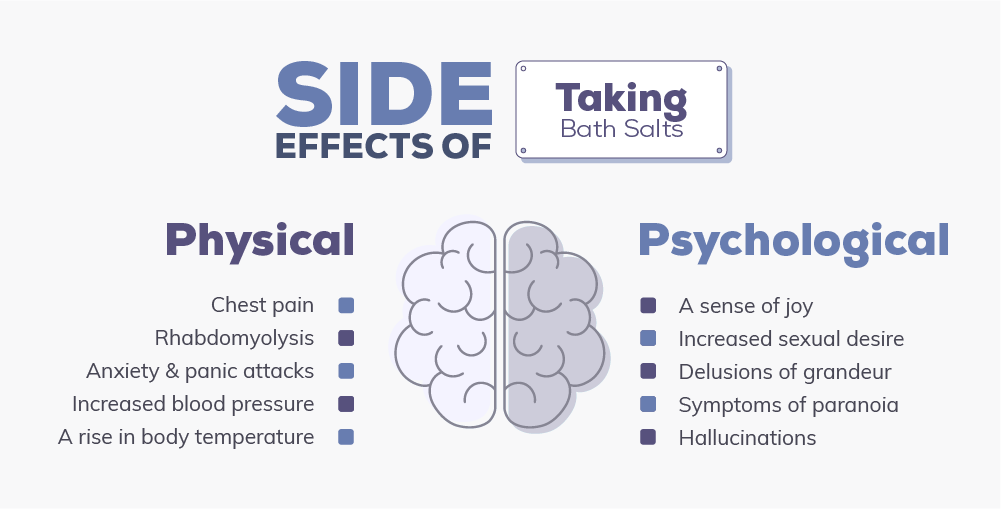
Even though scientists are not completely sure how bath salts impact the brain, it is believed that it floods it with dopamine. This is what results in many of the side effects.
Using bath salts even once can lead to a long list of side effects, such as:
People often use bath salts because they are looking forward to the psychological effects the drug can cause. Because it is a stimulant drug, it can produce a euphoric high. People typically experience:
For many drugs, short-term use does not result in any lasting consequences. But that is not the case for bath salts. People may experience significant issues, both physically and mentally, even after only using the drug once.
For example, some of the short-term effects of bath salts include:
Even with short-term use, it is possible to experience some fatal consequences of bath salts use. Anyone who uses this drug could be at risk of having a brainstem herniation. This occurs when there is an increase of pressure inside the skull. This can quickly lead to death.
When someone has been using bath salts long-term, the harm that is caused may be irreversible. For example, people can experience:
There is a difference between drug abuse and addiction, and it is important to understand those differences. When someone abuses a drug, they are typically only using it recreationally, and not because they feel they need it. They can stop at any time, usually without any ill effects.
Once someone has an addiction to a drug, they feel as though they must have it at all times. They feel compelled to use it, and they do not feel like themselves without it. It is a mental and physical need that is only satisfied when they are using their drug of choice. This is why the American Society of Addiction Medicine refers to it as a disease. They state that:
“Addiction is a primary, chronic disease of brain reward, motivation, memory and related circuitry…[it] is characterized by inability to consistently abstain, impairment in behavioral control, craving, diminished recognition of significant problems with one’s behaviors and interpersonal relationships, and a dysfunctional emotional response.”
At times, the terms abuse and addiction are used interchangeably, and this is incorrect. But, when it comes to bath salts, people can become addicted to them quicker than they think.
Because of the way that bath salts affect the brain, an addiction can happen very quickly. After using them for the first time, people are often not ready to experience the comedown period that occurs. This is an intense experience in itself, and it is quite emotionally and physically painful. People will frequently use again just to make those feelings go away.
Science is unclear about whether or not an addiction to bath salts can happen after just one use. But they do know that people who use once are very likely to use again and again, which is what leads to them become addicts.
People who are addicted to bath salts may display any of the following signs:
There are also some additional signs of addiction that they might experience as well. These are typically seen with any type of drug dependence. They include:
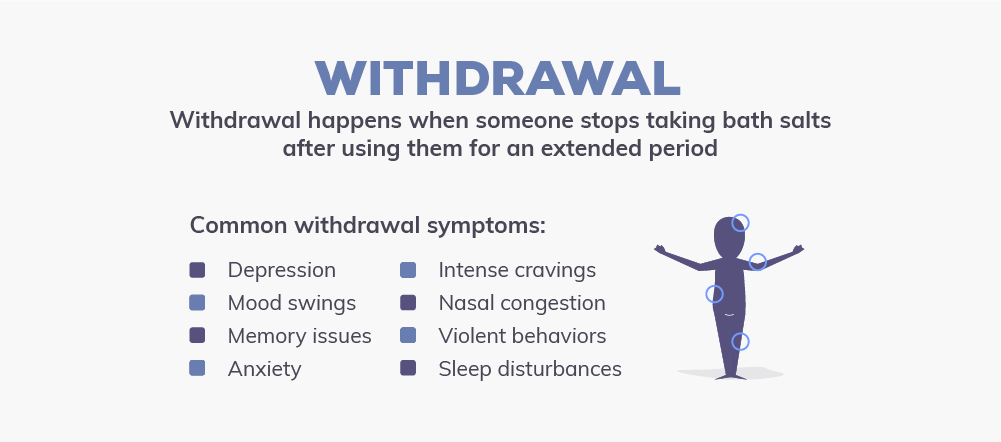
It is very common for people to have a hard time identifying an addiction in themselves by looking at a list of symptoms. Perhaps this is the way you feel as well. There are other ways that you can find out if you are addicted to bath salts. You may want to begin by taking a stimulants addiction quiz. By answering a series of questions, you can find out if you are an addict, and what steps you need to take to recover.
You may want to begin by talking with someone about your bath salts use. It is always a wise idea to speak with a professional about your drug use. They can tell you exactly what you need to do to get help. Many drug rehab programs offer free addiction assessments over the phone for this purpose.
Considering how dangerous bath salts are, the statistics surrounding their use are quite shocking. According to data presented by Newsweek on their website:
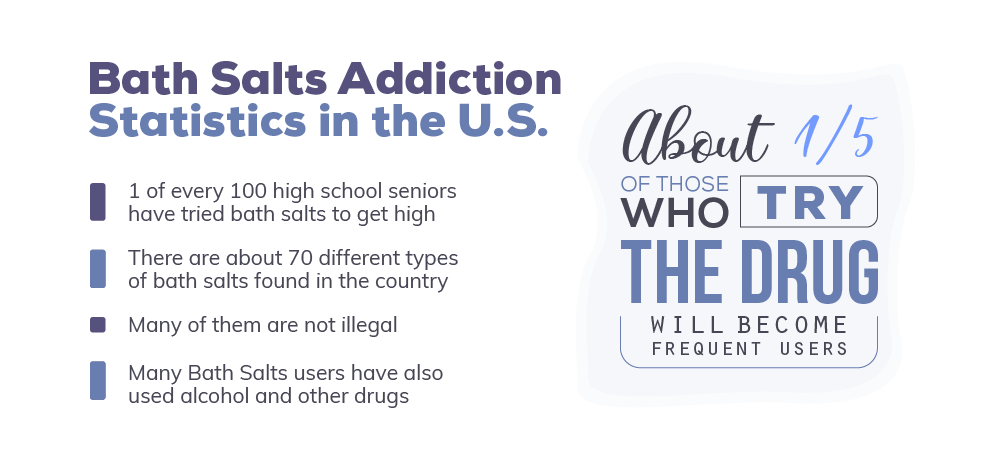
Once someone is addicted, it is nearly impossible to stop using bath salts on their own. Many attempt it only to end up relapsing again and again. Professional treatment is needed because this addiction is two-fold. Both parts of it need to be addressed, and they are the psychological aspect and the physical aspect.
This is achieved by attending both a drug detox program and a drug rehab program. Because of the nature of addiction, it is essential to deal with the physical part of it first. This allows people to get their withdrawal symptoms under control so they can safely work on determining what led to the substance abuse problem.
Bath salts is a very potent drug that, as we talked about earlier, leads to significant side effects. Stopping it can be extremely difficult, and this is not something most people can do on their own. In fact, it can be dangerous to abruptly stop using this drug, even though continuing its use also carries serious risks.
People do go through withdrawal when bath salts are stopped, which often leads them right back to using again. Going through drug detox can help them by lessening the severity of their symptoms and offering them relief.
Withdrawal happens when you stop taking bath salts (or almost any drug) after taking it for an extended period of time. The longer you were using it, the more severe your symptoms will be, typically.
Some of the more common symptoms of bath salts withdrawal include:
Complications can arise when stopping the use of bath salts without professional treatment. Depression may become so severe that it leads to suicidal thoughts or self-harming behaviors. Also, there could be heart issues as well.
Drug detox is done in a number of different ways. The goal is to remove those harmful toxins from your body safely, while making you as comfortable as possible. Many programs will tailor your treatment according to what will be best for you. But there are a few different methods that are considered to be the most popular and effective.
Medical detox is extremely popular, and it is widely used because it is thought to be the most effective method. This simply means that you will be able to take medications to help with your withdrawal symptoms. Your doctor will talk with you about what you are experiencing and prescribe medicine to help alleviate symptoms.
For example, someone who is detoxing off bath salts may be given an anti-depressant to help with anxiety, panic attacks and depression. If the person is considered to be at risk for seizures, and anti-convulsant may be ordered.
It is very important for these drugs to only be used short-term. Some of them can be addictive, and trading one addiction for another needs to be avoided.
A lot of detox centers will also prescribe holistic treatments for their patients as well. These are non-medical ways that can promote good health and an overall sense of well-being. Many will have their patients meet with a nutritionist for the purpose of improving their diets. They may include periods of exercise throughout the day as well. Other treatments might include Yoga and meditation.
When the body is given the right tools, it is very capable of detoxing on its own. This is why many detoxification programs will combine both medical and holistic methods. It allows them to provide their patients with the best possible treatments.
Once detox is over, people typically start to feel a lot better. They are able to think more clearly; although some of the effects from the bath salts may linger. As we mentioned earlier, there are some effects that may be irreversible. But it may seem as though you can just go home once your withdrawal symptoms are under control.
It is very important to continue on to a drug rehab to get additional help. This is where the mental part of the addiction is addressed.
During your drug rehab program, you will receive several different types of therapy. This will include working with a therapist in a one-on-one setting. It will also include group therapy sessions, 12-Step meetings and other forms of treatment.
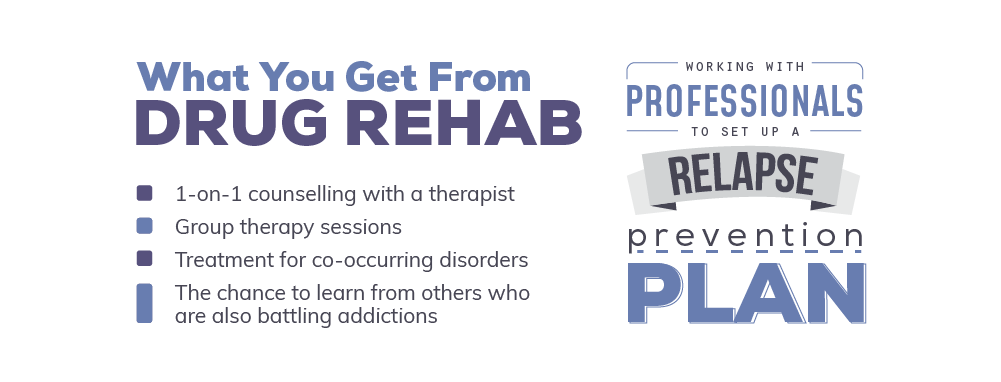
It is your therapist’s job to determine what it was that led to your addiction. It is possible that you suffer from a co-occurring disorder that needs to be treated. Many people struggle with depression, and they try bath salts as a way to feel happier. By treating the depression, these individuals have a much better chance of a long-term recovery.
Not every form of treatment is right for each person. There are a lot of ways to get help for an addiction, and it is important to understand what they are. This information will help you make the decision that is right for you.
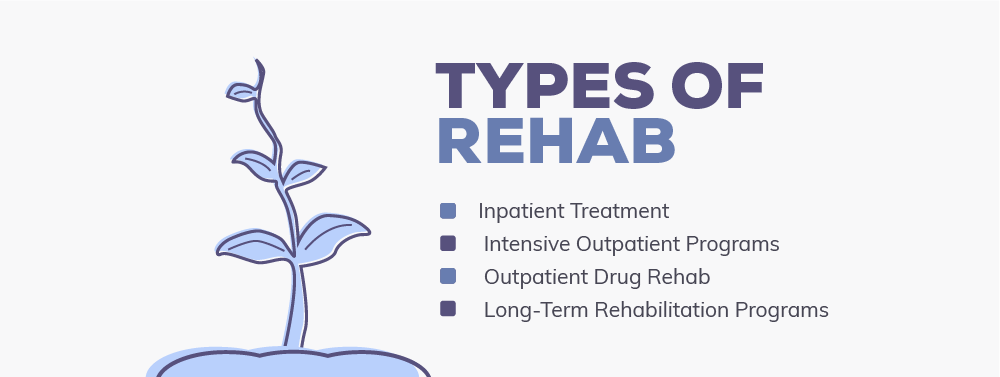
Inpatient programs are generally the most popular way of getting help for an addiction. They involve staying in a facility for a period of around 28 days. During that time, patients can go through detox if the facility offers it, and then they can move on to rehab afterwards.
There are a lot of benefits to going through inpatient rehab, which we will discuss in more detail in just a moment. It is known to be highly effective, and it helps to set people up for long-term success.
The reality is that not everyone is able to commit to an inpatient stay. Some people have responsibilities at home or at work that simply do not allow them to take that much time away. When that is the case, they may want to opt for an intensive outpatient program instead.
Intensive outpatient programs (or IOPs) offer patients a very high level of care in an outpatient setting. They are expected to attend treatment on various days throughout the week for several hours each time. Many IOPs offer their sessions in the evening, which makes it convenient for people who work during the day.
Research has shown that IOPs can be just as effective as inpatient treatment. But they might not be right for those who do not have stable home situations.
Many people would rather just go to a therapist on an outpatient basis once a week or so. This is often called outpatient rehab, but it is best reserved for those who have gone through a higher level of care. This form of treatment can be an excellent way to get continued support after completing an IOP or an inpatient program.
Sometimes people need a much more intensive form of treatment than they can find through an inpatient rehab. When this is the case, they are referred to a long-term treatment program, which may also be called residential treatment, or sober living.
These programs definitely have their benefits. Some offer in-house treatment, but in many cases, the residents are required to go to a local IOP. They can stay for several months at a time, and they work with a case manager while they are there.
Long-term rehab is best for those who have a history of relapsing, or who have failed other treatment methods in the past. It may also be recommended for those who need to relocate because of dangerous home environments.
In many cases, an inpatient treatment facility is the best option; especially for those with bath salts addiction. This drug is extremely dangerous, and stopping it is very difficult. The benefits of choosing this form of rehab include:
Of course, you will need to discuss your options with a professional prior to committing to any type of treatment. They will help you decide which form of rehab is right for you.
It is never a good idea to stop any drug cold turkey, and the same is true for bath salts. Stopping this drug abruptly will result in severe withdrawal symptoms, which could easily lead to a relapse. If you do have a relapse, you put yourself at risk for an overdose, which we will discuss in more detail in just a moment.
Quite often, people will turn to home remedies or holistic, natural detox treatments when they want to stop using a drug. These sound great, but there is no research to prove that they are effective. You can find a lot of products that promise excellent results, such as:
There is no safe way to detox from drugs at home. Attempting it puts you at a very high risk for a relapse and overdose. It is best to choose the professional treatment option for your own safety.
Typically, when people stop using a drug for a period of time, their tolerance levels go down. When this happens, it takes a smaller amount of the drug for them to get high, but they rarely realize this change has happened. When they relapse, they will often go back to using their prior dosage.
This is how many bath salts overdoses happen. This is a medical emergency and it needs to be treated by a doctor right away. If medical help is not found, this type of overdose can be fatal.
The signs and symptoms of a bath salts overdose include:
At Northpoint Washington, we offer a high-quality inpatient drug rehab and detox program. It has helped many people stop using, and a lot of people have been able to reach sobriety and maintain it.
Our accredited addiction treatment program runs for 28 days. During their stay with us, our patients receive the absolute best in care. We are located in Edmonds, Washington, which is a convenience for most of the people in the state.
We have worked hard to keep our patient population as small as possible. Our facility only has 22 beds, and that was purposefully planned. It allows us to provide our patients with more support because of our patient to staff ratio.
When patients come to us for services, they are often surprised to find that we offer both detox and rehab. We know the importance of starting with a quality medical detoxification program. This is especially true for people with bath salts addictions, or who are addicted to other synthetic drugs.
Once detox is over, our patients move on to drug rehab. There, they learn more about the reasons behind their addictions and what caused them. By working closely with a therapist in individual sessions, they are able to gain a lot of insight into their substance abuse problems.
But recovery does not end with rehab. On the contrary, it must continue in order for the patient to have hope for a positive long-term outcome. Of course, the type of ongoing treatment a person gets depends on their aftercare plan. Some may be transitioned into a local intensive outpatient program. Others may move on to outpatient rehab and NA meetings.
Many of the patients who come to us for help are suffering from co-occurring disorders. This term refers to the presence of one or mental health conditions that most likely caused the person to start using.
Dual diagnosis treatment is essential for anyone who has a co-occurring disorder. It is a method that allows both the mental illness and the addiction to be treated simultaneously. For someone who is addicted to bath salts, they could be suffering from any of the following:
Dual diagnosis treatment is still a very new form of care, but it is one that has shown to be very effective. In the past, addictions were treated separately from co-occurring disorders. This only contributed to the growing number of relapses and overdoses.
A lot of the patients we work with have cross addictions. That simply means that they are addicted to more than one substance or behavior. Failing to address these additional substance abuse problems typically results in a relapse.
A person who is addicted to bath salts may also be addicted to any number of other drugs. They can include:
Like co-occurring disorders, cross addictions are very common. People usually get addicted to a secondary substance because they are trying to enhance the high they experience. But what they do not realize is that second addiction can happen much faster than the first one. This is because all of the necessary addictive behaviors are already in place.
It can be very expensive to go to a drug rehabilitation center in Washington State. When a person is in need of both detox and rehab services, the cost can be as much as $10,000 for a 28-day stay. That makes getting treatment very difficult for most people unless they have health insurance.
But that should not be a cause for concern. Anyone who does not have health insurance can visit Healthcare.gov to shop for a policy. Also, there are many other ways to pay for rehab.
In the United States, health insurance companies are required by law to provide their patients with addiction treatment benefits. This often comes as a surprise to people because in the past, that was not the case. Most insurance companies did not offer this type of coverage, and those who needed to go to rehab had to pay out of pocket.
The Affordable Care Act was signed into law in 2010. This new healthcare law put several new policies in place, and this is just one of them. It also required everyone who is a U.S. citizen to have health insurance.
At Northpoint Washington, we know how difficult it can be to afford drug treatment on your own. We have made it a priority to become in-network with as many insurance companies as we can. That allows us to serve more people and provide them with the support they need to recover.

For many with bath salts addictions, recovery seems impossible. This is a drug that feels like it has a strong grip on you that is unable to be broken. We want you to know that we understand that here at Northpoint Washington. But we also know how to help you.
We offer drug detox and rehab services through our inpatient facility. We have worked with many people with this type of addiction in the past, and we can provide you with the assistance you need.

Our admissions coordinators are here to help you get started with treatment the right way. They'll verify your health insurance, help set up travel arrangements, and make sure your transition into treatment is smooth and hassle-free.
888.450.2153Contact Us